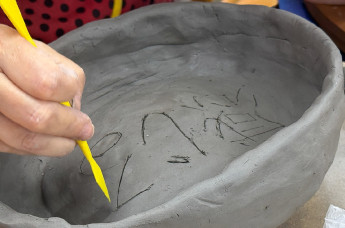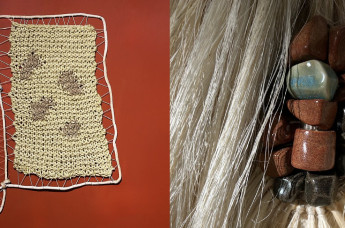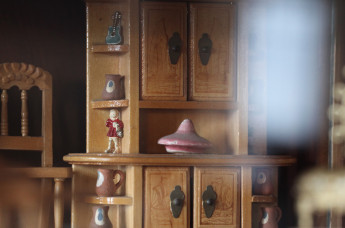Each of the venues that will host these exhibitions forms a special chapter of the curatorial axis Modes of Inhabiting proposed for the third edition of BIENALSUR.
On Friday, November 12, chapters 1 and 2, Ephemeral architectures and Re-reading signals – re-imagining spaces, will inaugurate at the Espacio de Arte Contemporáneo (EAC) and the Museo Nacional de Artes Visuales (MNAV), respectively. And, on Saturday the 13th, chapters 3, 4 and 5 will be presented: Urban Camouflages, Signs of the Everyday and Anarchitekton, at the Centro Cultural de España (CCE), the Museo de Arte Precolombino e Indígena (MPAI) and at the SUBTE Centro de Exposiciones.
Around 60 artists from America, Europe and Asia participate in the different projects that BIENALSUR presents in its 2021 edition under the curatorial axis Modes of Inhabiting in Montevideo, Uruguay.
Curated by the Argentine Diana Wechsler, BIENALSUR’s Artistic Director, and Liliana Piñeiro, the Italian Benedetta Casini and the Uruguayan Enrique Aguerre, the exhibitions and installations raise the need to assume the mechanisms that regulate the spaces in which we live and to find a way to live with them in a manner that is imaginative and disruptive at the same time.
Chapter 1, Ephemeral Architectures, opens on November 12 at 12:30 p.m. at Espacio de Arte Contemporáneo (EAC), a former prison in Migueletes. Curated by Benedetta Casini and Liliana Piñeiro, it consists of two site-specific interventions that explore the transformations of Latin American cities under the sign of neoliberal capitalism.
The installation “Third greyhound”, by the Argentine Bruno del Giudice, investigates the architecture of popular fairs such as La Salada and the proliferation of “false brands”. “Here, the local and the global overlap and the insignia of globalization are appropriate and re-signified according to the context. The light that filters through the pictorial installation gives us back fragments that are not entirely recognizable from different brands, which outline the desires and aspirations that congregate around them, to give us back, as in a mirror, a simulacrum of originality”, explains Casini. For its part, the installation "Propagation of wishes", by Brazilian Alan Oju, uses the corridor of the former Migueletes prison to cover it with posters used to promote real estate projects, with phrases such as "living between the sky and the sea"," Live up to it ","live the style". The artist decontextualizes them and ironizes about the neoliberal language of well-being and meritocracy. "Oju turns each poster into an empty slogan, whose location in the panoptic architecture of the ex-prison shows the parallelism between two modes of production of subjectivities: the control over the bodies and the desires induced by the consumption system", completes the Italian curator.
Ephemeral Architectures will take place at Km 202 of BIENALSUR and will be open to visit until March 6 of 2022.
Meanwhile, chapter 2, Rereading signals - re-imagining spaces, will present from the same Friday at 2 p.m. at the Museo Nacional de Artes Visuales (MNAV), with productions by the Swede Peter Johansson, the Saudi Muhannad Shono, and pieces by the MNAV Collection.
“Kiosk”, by Johansson, is a site-specific work inspired by the police watch boxes in the city of Montevideo. “By stylizing the structure and stripping it of its identity characteristics, Johansson points out its similarity with other urban elements of different uses and destinations, such as food trucks and food kiosks, and stimulates reflections on the symbolic value of the boxes, the concept of the prefabricated and the standardization of experiences”, indicates its curatorial text. In the case of Shono, his exhibition “Re-reading signals, re-imagining spaces”, in dialogue with the Museum's collection and curated by Diana Wechsler and Enrique Aguerre, has as a central element the sand and its poetic power, as the bearer of narratives that appear to illuminate some aspect of the present while shutting off others.
“This project prepared by Shono especially for BIENALSUR in MNAV takes as a starting point his childhood memories. The plans of what was his house constitute the indicative principle of this work: occupying the voids, making each space represented in two dimensions a volume, exploring with them -through their presence, their multiple combinations, their erosion and the traces that this leaves-, emerging narratives are part of his inquiries. These essays help shape a new home idea that sits and is built to properly remodel, refurbish, and revise. Sometimes –adds the artist– we have to deform and erode the past, disassemble our concepts from the structures and molds that surround them, unlearn narratives, to recreate our own stories and realities. Shono's proposal is the trigger for this short selection of works from the MNAV Collection. The coexistence of these images, we trust that it can offer –like the sand that covers and reveals diverse landscapes– other narratives”, Wechsler points out.
This chapter will take place at Km 204 of BIENALSUR and may be visited until January 16, 2022.
On Saturday the 13th at 3 p.m. will open chapter 3, Urban Camouflage, at Centro Cultural de España (CCE), with works by the Spanish Jordi Colomer and Javier Rodríguez Lozano, the Slovak Danilo Milovanovic, the Uruguayan Valentina Cardellino, the Argentine Francisco Estarellas, the Dutch Koen Taselaar, the Chilean Gianfranco Foschino and the Colombian Yohn Jader Bedoya. Curated by Casini and Piñeiro, this proposal summarizes the most representative works of the Modes of Inhabiting axis proposed for BIENALSUR 2021.
“Arising from the proposals received in the 2020 Open Call, the axis shows the urgency that artists from all over the world express by thinking and questioning how we live in cities and showing how their devices latently condition our subjectivities. Thinking about the concept of “camouflage” as a resource for evolutionary adaptation allows us to describe the practices of the artists who present their works at the CCE; works that pose the need to assume the mechanisms that regulate the spaces in which we live and to find a way to coexist with them in a manner that is imaginative and disruptive at the same time”, summarizes Casini.
Continuing with the openings on Saturday, at 4 p.m., chapter 4, Signs of the everyday, will be open to the public at the Museo de Arte Precolombino e Indígena (MAPI). Curated by Wechsler, Casini and Piñeiro, this installation focuses on the online project “The Crown Letter”, which brings together works by 46 female artists from different parts of the world around the new ways of living imposed by the pandemic. This exhibition includes creators such as the French Natacha Nisic, Anne Brunswic, Claire Chevrie, Emmanuelle Pellegrini and Pascale Criton; the British Kate Blacker, Ruth Maclennan and Liza Dimbleby; the Germans Alisa Berger, Luise Schröder, Jutta Doberstein and Katja Stuke; the Irish Dettie Flynn and Michelle Deignan; the Japanese Mutsumi Tsuda, Kyoko Kasuya and Mika Shigemori; Maithili Bavkar, Sudha Padmaja Francis and Saviya Lopez; the Americans SE Barnet and Andrea Blum; and the Argentine Adriana Bustos, Silvana Deluigi, Julieta Hanono and Ivana Vollaro, among many others.
Signs of the everyday will be available until December 13 of 2021.
Finally, this string of openings will close at 5 p.m. in the SUBTE Centro de Exposiciones with chapter 5, Anarchitekton, starring the Spanish Jordi Colomer, and curated by Casini.
“Jordi Colomer presents an adaptation of one of his most representative projects, Anarchitekton, designed specifically for the SUBTE space. Three large-scale images from the videos that make up the proposal introduce Idroj Sanicne's wanderings through the streets of Barcelona, Bucharest, Osaka and Brasilia, in which the artist wields models of iconic buildings from each of these cities. The real architectures and their simulations are superimposed on the chained still images that follow one another on the monitor, in an invocation to silent cinema and the universe of animation. The rough finish of the cardboard and wood models suggests the cartoonish and ironic intentionality of Colomer, who takes up, to contradict them, the Arquitectones produced between 1920 and 1925 by Kazimir Malévich -geometric and abstract constructions without a reference model or scale. The models by the Spanish artist, on the other hand, not only refer to a precise model but also parody it, presenting themselves as wandering and poor –more specifically anarchic– versions of their monumental originals that appear in the background. Displayed as posters in public protests, the models also allude to the tradition of Russian constructivism, whose architectural projects were assumed as symbols of a renewed society. Leaving their static hieraticity, the buildings appropriated by Colomer take to the streets and mix up with life, condensing in their replicas the imaginaries, desires and illusions that inhabit contemporary cities”, explains the curator.
Chapter 5 will be housed by Km 203 of BIENALSUR and will be open to the public until February 5, 2022.
Uruguay thus returns to participate in BIENALSUR, which in its third edition takes place simultaneously in more than 124 venues, 24 countries and 50 cities around the world from July to December 2021 with the participation of around 400 artists.




